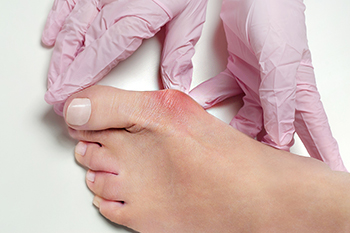
A small hardened lump on the outside of the big toe may indicate a bunion has formed. It can grow in size if treatment is not sought, and can cause the other toes to shift toward each other. Bunions form as a result of genetic factors, or they may happen from wearing shoes that do not have adequate room for the toes to move in freely. It is considered to be a deformity and may be painful, often causing difficulty in walking. Some patients notice there is redness and swelling surrounding the bunion, and it may reduce range of motion in the big toe. Relief may be found when the correct size shoes are worn, with enough room for the toes to move in. Additionally, orthotics may be worn which may improve comfort and foot alignment. Corns may form on top of the bunion, where it rubs against the shoe, and wearing a protective pad over the bunion may temporarily provide relief. If you have a bunion, it is suggested that you consult with a podiatrist who can offer you treatment solutions, which may include minor surgery for permanent removal.
If you are suffering from bunion pain, contact Anas Khoury, DPM of North Eastern Foot & Ankle Specialists. Our doctor can provide the care you need to keep you pain-free and on your feet.
What Is a Bunion?
Bunions are painful bony bumps that usually develop on the inside of the foot at the joint of the big toe. As the deformity increases over time, it may become painful to walk and wear shoes. Women are more likely to exacerbate existing bunions since they often wear tight, narrow shoes that shift their toes together. Bunion pain can be relieved by wearing wider shoes with enough room for the toes.
Causes
- Genetics – some people inherit feet that are more prone to bunion development
- Inflammatory Conditions - rheumatoid arthritis and polio may cause bunion development
Symptoms
- Redness and inflammation
- Pain and tenderness
- Callus or corns on the bump
- Restricted motion in the big toe
In order to diagnose your bunion, your podiatrist may ask about your medical history, symptoms, and general health. Your doctor might also order an x-ray to take a closer look at your feet. Nonsurgical treatment options include orthotics, padding, icing, changes in footwear, and medication. If nonsurgical treatments don’t alleviate your bunion pain, surgery may be necessary.
If you have any questions, please feel free to contact our office located in Passaic, NJ . We offer the newest diagnostic and treatment technologies for all your foot care needs.
